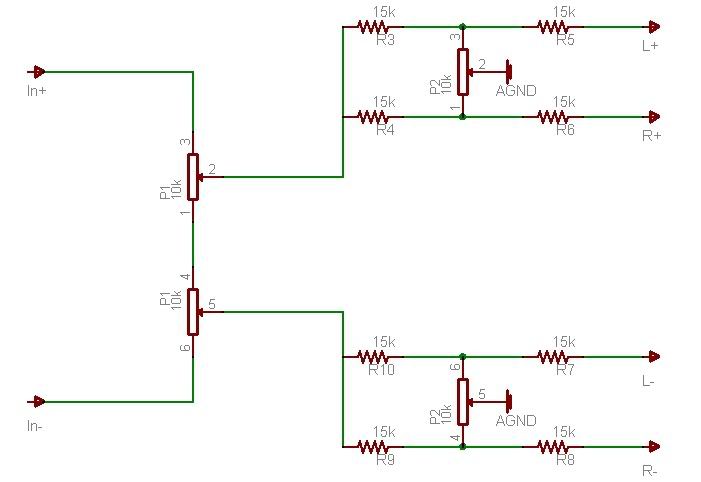enthalpystudios
Well-known member
How would this work, if fed from a low impedance, transformer balanced source?

I still need to work out the make up gain, and I'm hoping that my assumption is correct when I assume that R5-R8 are the summing resistors. The only few references to this orban style pan pot I've seen show it feeding a virtual ground active summing stage... any reason the stage can't be passive summing with makeup gain?
i have no need for bus switching or in place solo... a simple mute and pfl perhaps, but i'm not even thinking about those at the moment. just thinking about summing 24 channel from the tape machine so i can *listen* to it, and pan it ;]
Since i need very few frills, I figured that fully balanced would be perhaps a good idea since I lack the experience to design a really low noise active ground setup... my hopes are to bring each side (L/R) to their respective busses and add shunt R's to bring the impedance down around 150 ohms and feed a mic pre for now.... around 175 ohms or so across the +/- inputs to the mic pre?
this is really similar to NYD's (thanks dave) "balanced mix network" although the fader/attenuator is 10k rather than 5k, and I'm pretty much hoping I'm close on the pan pot. i just figured I'd see what knowledgable people thought about the values, as they were all just chosen to match 10k parts. not so easy to find a good price on 100mm log faders or pc mount dual lins (esp. with center detent) aside from 10k. colin at audio maintenance has these parts at good prices is why I'm hoping to be able to use them
thanks if anyone has any comments
billy

I still need to work out the make up gain, and I'm hoping that my assumption is correct when I assume that R5-R8 are the summing resistors. The only few references to this orban style pan pot I've seen show it feeding a virtual ground active summing stage... any reason the stage can't be passive summing with makeup gain?
i have no need for bus switching or in place solo... a simple mute and pfl perhaps, but i'm not even thinking about those at the moment. just thinking about summing 24 channel from the tape machine so i can *listen* to it, and pan it ;]
Since i need very few frills, I figured that fully balanced would be perhaps a good idea since I lack the experience to design a really low noise active ground setup... my hopes are to bring each side (L/R) to their respective busses and add shunt R's to bring the impedance down around 150 ohms and feed a mic pre for now.... around 175 ohms or so across the +/- inputs to the mic pre?
this is really similar to NYD's (thanks dave) "balanced mix network" although the fader/attenuator is 10k rather than 5k, and I'm pretty much hoping I'm close on the pan pot. i just figured I'd see what knowledgable people thought about the values, as they were all just chosen to match 10k parts. not so easy to find a good price on 100mm log faders or pc mount dual lins (esp. with center detent) aside from 10k. colin at audio maintenance has these parts at good prices is why I'm hoping to be able to use them
thanks if anyone has any comments
billy


